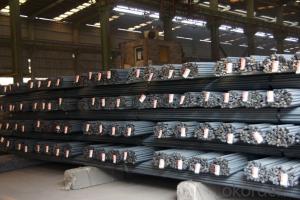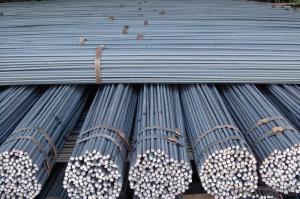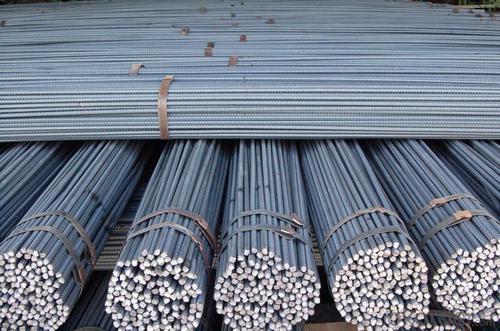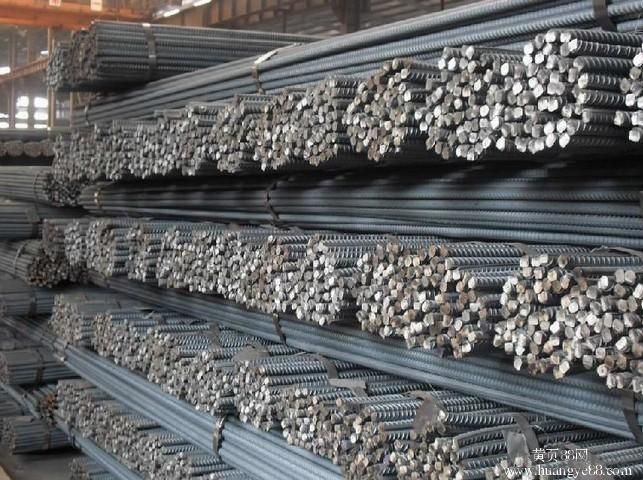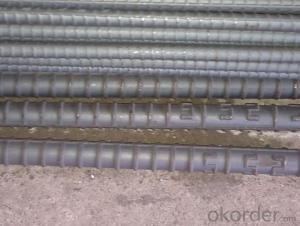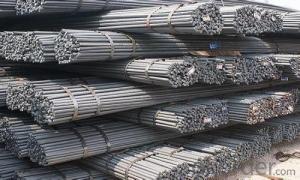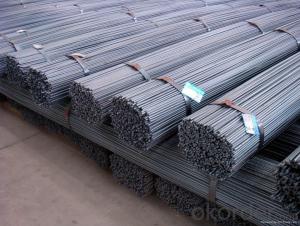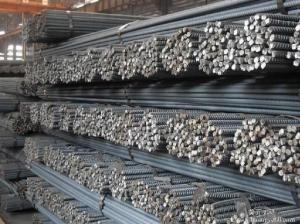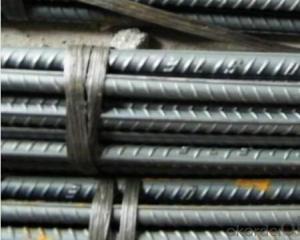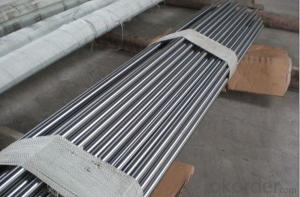Deformed bars with grade HRB400,high quality
- Loading Port:
- Tianjin
- Payment Terms:
- TT OR LC
- Min Order Qty:
- 25 m.t.
- Supply Capability:
- 100000 m.t./month
OKorder Service Pledge
OKorder Financial Service
You Might Also Like
Product Description:
Specifications of HRB400 Deformed Steel Bar:
Standard | GB | HRB400 | |
Diameter | 10mm-32mm | ||
Length | 6M, 12M | ||
Place of origin | Hebei, China mainland | ||
Advantages | exact size, regular package, chemical and mechanical properties are stable. | ||
Type | Hot rolled deformed steel bar | ||
Chemical Composition: (Please kindly find our chemistry of our material based on HRB400 as below for your information)
Grade | Technical data of the original chemical composition (%) | ||||||
C | Mn | Si | S | P | V | ||
HRB400 | ≤0.25 | ≤1.60 | ≤0.80 | ≤0.045 | ≤0.045 | 0.04-0.12 | |
Physical capability | |||||||
Yield Strength (N/cm²) | Tensile Strength (N/cm²) | Elongation (%) | |||||
≥400 | ≥570 | ≥14 | |||||
Theoretical weight and section area of each diameter as below for your information:
Diameter(mm) | Section area (mm²) | Mass(kg/m) | Weight of 12m bar(kg) |
18 | 254.5 | 2.00 | 24 |
20 | 314.2 | 2.47 | 29.64 |
22 | 380.1 | 2.98 | 35.76 |
Usage and Applications of HRB400 Deformed Steel Bar:
Deformed bar is widely used in buildings, bridges, roads and other engineering construction. Big to highways, railways, bridges, culverts, tunnels, public facilities such as flood control, dam, small to housing construction, beam, column, wall and the foundation of the plate, deformed bar is an integral structure material. With the development of world economy and the vigorous development of infrastructure construction, real estate, the demand for deformed bar will be larger and larger..
Packaging & Delivery of HRB400 Deformed Steel Bar:
Packaging Detail: products are packed in bundle and then shipped by container or bulk vessel, deformed bar is usually naked strapping delivery, when storing, please pay attention to moisture proof. The performance of rust will produce adverse effect.
Each bundle weight: 2-3MT, or as required
Payment term: TT or L/C
Delivery Detail: within 45 days after received advanced payment or LC.
Label: to be specified by customer, generally, each bundle has 1-2 labels
Trade terms: FOB, CFR, CIF

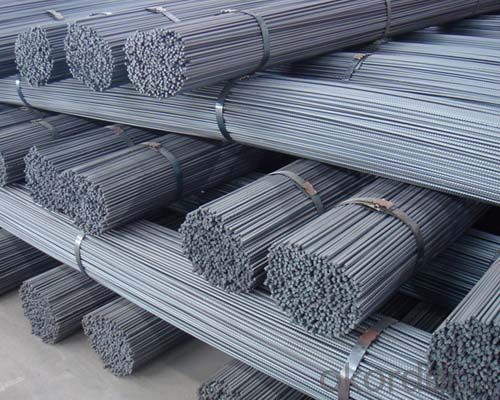
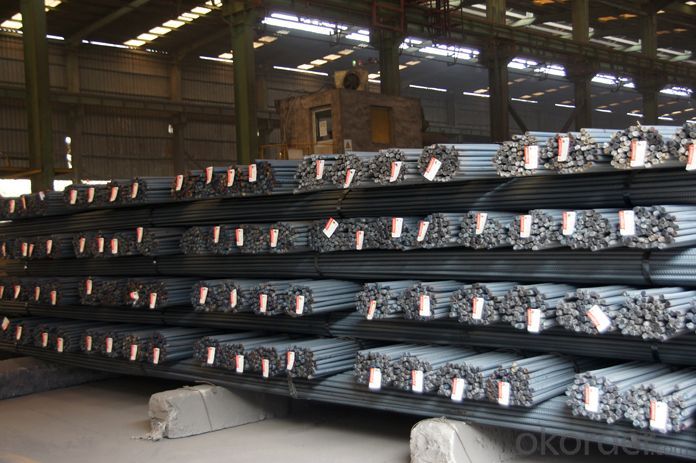
*If you would like to get our price, please inform us the size, standard/material and quantity. Thank you very much for your attention.
- Q: Are there any safety precautions to be followed while working with steel rebars?
- Yes, there are several safety precautions that should be followed while working with steel rebars. These include wearing appropriate personal protective equipment such as gloves, safety glasses, and steel-toed boots to protect against potential hazards. It is important to handle rebars with caution to avoid cuts, punctures, or strains, and to use proper lifting techniques when moving heavy or long pieces. Additionally, workers should be aware of their surroundings, maintain a clean and organized workspace, and follow all relevant safety guidelines and procedures to minimize the risk of accidents or injuries.
- Q: What is the effect of steel rebars on the formwork design?
- Steel rebars have a significant effect on the formwork design in construction projects. These rebars, also known as reinforcement bars, are used to provide strength and stability to concrete structures. One of the main effects of steel rebars on formwork design is the need for proper positioning and spacing of the rebars within the formwork. The formwork needs to be designed to accommodate the rebars and allow for their proper placement in order to ensure the structural integrity of the concrete element. This may involve creating openings or recesses in the formwork to allow the rebars to pass through. The presence of steel rebars also affects the size and dimensions of the formwork. Since the rebars occupy space within the concrete element, the formwork needs to be adjusted accordingly to accommodate these additional materials. This may require increasing the size or thickness of the formwork to accommodate the desired concrete cover over the rebars. Another effect of steel rebars on formwork design is the consideration of the weight and load-bearing capacity of the formwork system. Steel rebars can add significant weight to the concrete structure, and the formwork needs to be designed to withstand this additional load. This may involve using stronger and more robust materials for the formwork, as well as ensuring proper bracing and support. Furthermore, the presence of steel rebars may also impact the formwork construction process. The formwork needs to be carefully designed to allow for the installation and removal of the rebars without compromising the integrity of the formwork system. This may involve incorporating removable sections or panels in the formwork design to facilitate the placement and removal of the rebars. In conclusion, steel rebars have a significant effect on the formwork design in construction projects. They require careful consideration and planning to ensure proper positioning, spacing, and support within the formwork. The presence of rebars also affects the size, dimensions, weight, and construction process of the formwork system. Overall, proper integration of steel rebars within the formwork design is crucial for the successful construction of durable and structurally sound concrete elements.
- Q: How do steel rebars perform in extreme weather conditions?
- Steel rebars perform well in extreme weather conditions. Steel is highly resistant to temperature changes, which helps maintain its strength and integrity. It can withstand high winds, heavy rain, and extreme cold without losing its structural stability. Additionally, steel rebars have excellent corrosion resistance, minimizing the risk of damage caused by moisture or salt exposure. As a result, steel rebars are a reliable choice for construction projects in areas prone to extreme weather conditions.
- Q: Can steel rebars be welded or spliced together?
- Yes, steel rebars can be welded or spliced together. Welding is a common method used to join steel rebars together. It involves heating the rebars to a high temperature and then using a welding electrode to melt the steel and create a strong bond between the rebars. Welding is often used in construction projects where a continuous reinforcement is required. Splicing, on the other hand, involves connecting two rebars using mechanical connectors or couplers. These connectors are designed to provide a strong and reliable connection between the rebars. Splicing is often used when rebars need to be extended or when there is a need to join different rebars together. Both welding and splicing methods have their advantages and disadvantages. Welding provides a continuous reinforcement and creates a strong bond between the rebars, but it requires skilled labor and can be time-consuming. Splicing, on the other hand, is quicker and easier to perform, but it may result in a slight reduction in the overall strength of the reinforcement. It is important to note that the use of welding or splicing for steel rebars should comply with the relevant codes and standards, as well as be approved by the structural engineer or the responsible authority.
- Q: Can steel rebars be used in high-rise construction projects?
- Yes, steel rebars can definitely be used in high-rise construction projects. In fact, they are widely used in the construction industry for their strength and durability. Steel rebars are typically used in reinforced concrete structures, including high-rise buildings, to provide tensile strength and reinforce the concrete against cracking or failure. The use of steel rebars in high-rise construction projects helps to ensure the structural integrity and stability of the building. Additionally, steel rebars allow for flexibility in design and can be easily customized to meet the specific requirements of each project. Overall, steel rebars are an essential component in high-rise construction and play a crucial role in ensuring the safety and longevity of these structures.
- Q: How to calculate the theoretical elongation of finishing thread steel?
- The grade of prestressed concrete rebar is defined by the yield strength. The code is PHB, plus the minimum value of the specified yield strength. P, H and B are English first letters of Prestressing, Hot and Bars respectively. For example: PHB830 represents a steel bar with a minimum yield strength of 830MPa.
- Q: Grade 1, grade three, grade two, steel, wire rod, round bar
- Round steel is a solid strip of steel whose cross section is round. The specifications are expressed in millimeters of diameter, such as "50", which means a round bar of 50 millimeters in diameter. Round bar is divided into three parts: hot rolling, forging and cold drawing. Standard Specification for hot rolled round steel is 5.5-250 mm. Among them, 5.5-25 mm small round bars are mostly supplied by straight strips. They are used as reinforcing bars, bolts and various mechanical parts. They are more than 25 millimeters of round steel. They are mainly used in the manufacture of mechanical parts or seamless steel tube billets.
- Q: What is the tensile strength of steel rebars?
- The tensile strength of steel rebars typically ranges from 400 to 600 megapascals (MPa).
- Q: Can steel rebars be used in tunnel lining construction?
- Tunnel lining construction readily employs steel rebars, given their exceptional tensile strength and durability. These rebars are extensively utilized as they furnish structural reinforcement to the concrete lining, assuring its stability and long-term performance. Typically, the rebars are embedded within the concrete lining, creating a robust composite structure that effectively withstands the various loads and pressures encountered in tunnel environments. Moreover, steel rebars can be easily molded and flexed to conform to the tunnel's shape, facilitating efficient and precise construction. Overall, steel rebars represent an indispensable element in tunnel lining construction, guaranteeing the essential strength and structural integrity that safeguard the safety and longevity of the tunnels.
- Q: In the concrete floor, how big can the steel bar be replaced by the big screw steel? How to convert?
- Tensile strength, extensibility, yield point! The same thread can be used instead!Of course, the number of roots must also be the same ~ only specifications vary!
Send your message to us
Deformed bars with grade HRB400,high quality
- Loading Port:
- Tianjin
- Payment Terms:
- TT OR LC
- Min Order Qty:
- 25 m.t.
- Supply Capability:
- 100000 m.t./month
OKorder Service Pledge
OKorder Financial Service
Similar products
Hot products
Hot Searches
Related keywords
